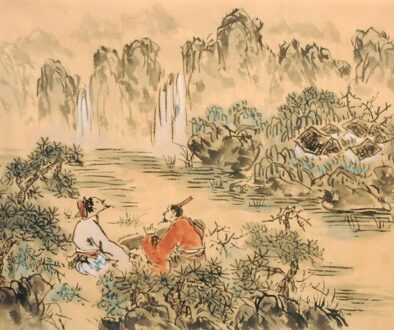The Foundation of Guqin is Carried on in the West
By Jack Tianji Xie, excerpt from The Way of the Guqin
The guqin is the representative of the high culture of the East, with a long history and rich inheritance. The way of the guqin is wrought with Chinese philosophy and aesthetics; it is also the highest pursuit of ethics and temperament of our cultured people since antiquity. Most guqin music has profound historical implications. As a result, both Chinese and foreign scholars and guqin specialists all value it, love it and strongly promote its propagation and development in the West.
In this regard, we must first look back to the Qianlong years (1711 – 1799) of the Qing Dynasty when the French missionary J.J.M. Amiot who was made a musician in the royal court by royal edict of the Qianlong Emperor. He taught Western music and studied Chinese music. After 40 years, he completed On the Ancient and Present Music of China (Zhongguo Yinyue Gujin Ji) which was published in Paris in 1780. This book studied the whole system of Chinese musicology. It also introduced guqin, Marvelous Music (Shenqi Mipu), Music of Ancient Times (Taigu Yiyin), Guqin Music Scores from Olden Days (Yifa Qinpu), etc. We can say that he is the first person to start the introduction of the guqin to the West.
Later, G. Soulie brought forth a chart of the simplified 44 notations of guqin music. L. Laloy wrote Chinese Music (Zhongguo Yinyue), in which the guqin was studied from the point of view of aesthetics. In 1924, M. Courant published A Study on Elegant Chinese Music (Zhongguo Yayue Yanjiu) in which he further studied the universality of Chinese music from a macro perspective, and the methods of adjusting guqin strings as well as the methods of guqin notation from a micro perspective. He wrote out 12 pieces of guqin music and translated them into the five-line music staff. This is a historical first step for guqin music to be introduced to the West.
In 1941, Robert Van Gulik (1910 – 1967) published The Lore of the Chinese Lute which, using a professional, historical and logical method, is a specialized book with wide scope and depth in the study of the guqin. In the 1940’s, the great guqin masters Wei Zhongle and Zha Fuxi performed guqin on stage in New York for the first time in the United States. That grand occasion is similar in importance to Mei Lanfang’s performing Peking opera in New York. It was the first time the Westerners enjoyed the Eastern guqin culture with their eyes and ears.
In the 1950’s (1957), Zhou Wenzhong first created the piano piece “Willow’s New Hue (Liuse xin) from the guqin music “Three Stanzas of the Yang Pass”. From then on, he continually introduced the superior qualities and aesthetic beauty of the guqin to the West. In the 1970’s, as a national literary and art academician in the United States, he strongly recommended the famous guqin piece, “Flowing Water (Liushui)”, to the U.S. Space Agency to carry it into outer space. This created a new assessment of guqin art for the world. During the same period, Liang Mingyue published the special Studies of the Guqin (Guqin yanjiu) in the United States.
In the 90’s (1998), the Fromm Music Foundation of Harvard University commissioned composer Zhu Jian’er to create the tenth symphony “River Snow (Jiangxue)” (Liu Zhongyuan’s poem). For the first time, he introduced the guqin piece “Three Stanzas on the Plum Blossom (Meihua sanlong)” into the symphony, intertwining the atonal twentieth century symphony with fourth century Chinese music “Three Stanzas on the Plum Blossom” to become a completely new modern piece. This caused quite a sensation in the world. After the year 2000, guqin masters Wu Wenguang, Li Xiangting, Gong Yi, Cheng Gongliang, Lin Youren and others have often travelled to the West to introduce guqin culture.
The above is only a simple introduction, but it is already quite impressive! With this background, with the publication of Ms Tang’s The Way of the Guqin, following the paths of the previous worthies, during the rise of the Chinese economy and culture, she has taken one more step forward in history. What are the special features of her book?
I think the structure of the book is well-knit and the writing is clear. The author takes a birds-eye view perspective of the three thousand year old Chinese cultural holy musical instrument, making a scan of the whole, the concise and its essence. It gives the reader a refresh look and an outline understanding of the way of the guqin. Furthermore, it is published both in Chinese and English, so it is suitable for overseas Chinese and Westerners alike. The book is appended with nearly 40 guqin music pieces which are divided into 10 grades and is quite an assembly of guqin music. It can be called a practical handbook for learning guqin. And, the discussions and the corroborating scores will bring beneficial reference and revelation to Western music circles.
Diana Tang’s writings show a certain foundation in the study of the guqin. Her teacher is Qiao Shan whose teacher is Wang Di whose teacher is Guan Pinhu. Guan Pinghu’s teacher was Yang Shibai. From this angle, she is a fifth generation adept with impressive predecessors. These earlier generations are all great and famous specialists. Diana Tang belongs to the Northern Jiuyi School whose style is unadorned and pure, agile and vigorous.
In 2016, urged by Luo Fu, Diana opened a guqin studio called: “Stringless House” in Vancouver. Ever since then, she has been studying musicology and the foundations of music theory with me. For the past three years, I have been moved by her curiosity and hard-working spirit. I also found out that she teaches guqin and makes friends there in her guqin studio. As well, she exchanges views with people of “Confucian, Daoist and Buddhist” studies. Furthermore, she often travels to temples in mountains to seek Buddhist wisdom and Buddhist capability beyond nature to enrich the Zen state of guqin art. This is where she has a special innate intelligence.
Ms Tang is rather like a devout guqin propagator. In this great era when eastern and western cultures intermingle, I hope that she, together with her guqin, here in this western country will enjoy great success in propagating the seeds of guqin!



